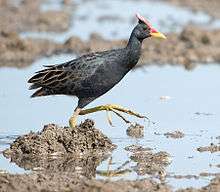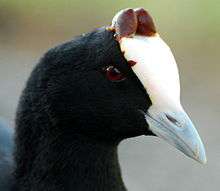Frontal shield
_(3).jpg)
A frontal shield, also known as a facial shield or frontal plate, is a feature of the anatomy of several bird species. It consists of a hard or fleshy plate of specialised skin extending from the base of the upper bill over the forehead. The size, shape and colour may exhibit testosterone-dependent variation in either sex during the year.[1] Functionality appears to relate to protection of the face while feeding in, or moving through, dense vegetation, as well as to courtship display and territorial defence.[2] It is a characteristic of some water birds in the rail family, especially the gallinules and moorhens, swamphens and coots, as well as in the Jacana family.[3][4] The watercock's frontal shield is extended above the head into a horn-like protuberance. A bird from a different order, the extinct Choiseul pigeon, had a blue frontal shield.
Gallery
-

Watercock
See also
References
- ↑ Alvareza F, Sanchez CS, Angulo S (2005). "The frontal shield of the moorhen: sex differences and relationship with body condition". Ethology, Ecology & Evolution. 17 (2): 135–148. doi:10.1080/08927014.2005.9522603.
- ↑ Gullion, Gordon W. (1951). "The frontal shield of the American Coot". Wilson Bulletin. 63 (3).
- ↑ Campbell, Bruce; & Lack, Elizabeth. (Eds). (1985). A Dictionary of Birds. Calton, United Kingdom: Poyser. p. 533. ISBN 0-85661-039-9.
- ↑ Mayntz, Melissa. "Frontal Shield". Birding / Wild Birds. Abot.com. Retrieved 2014-01-14.


